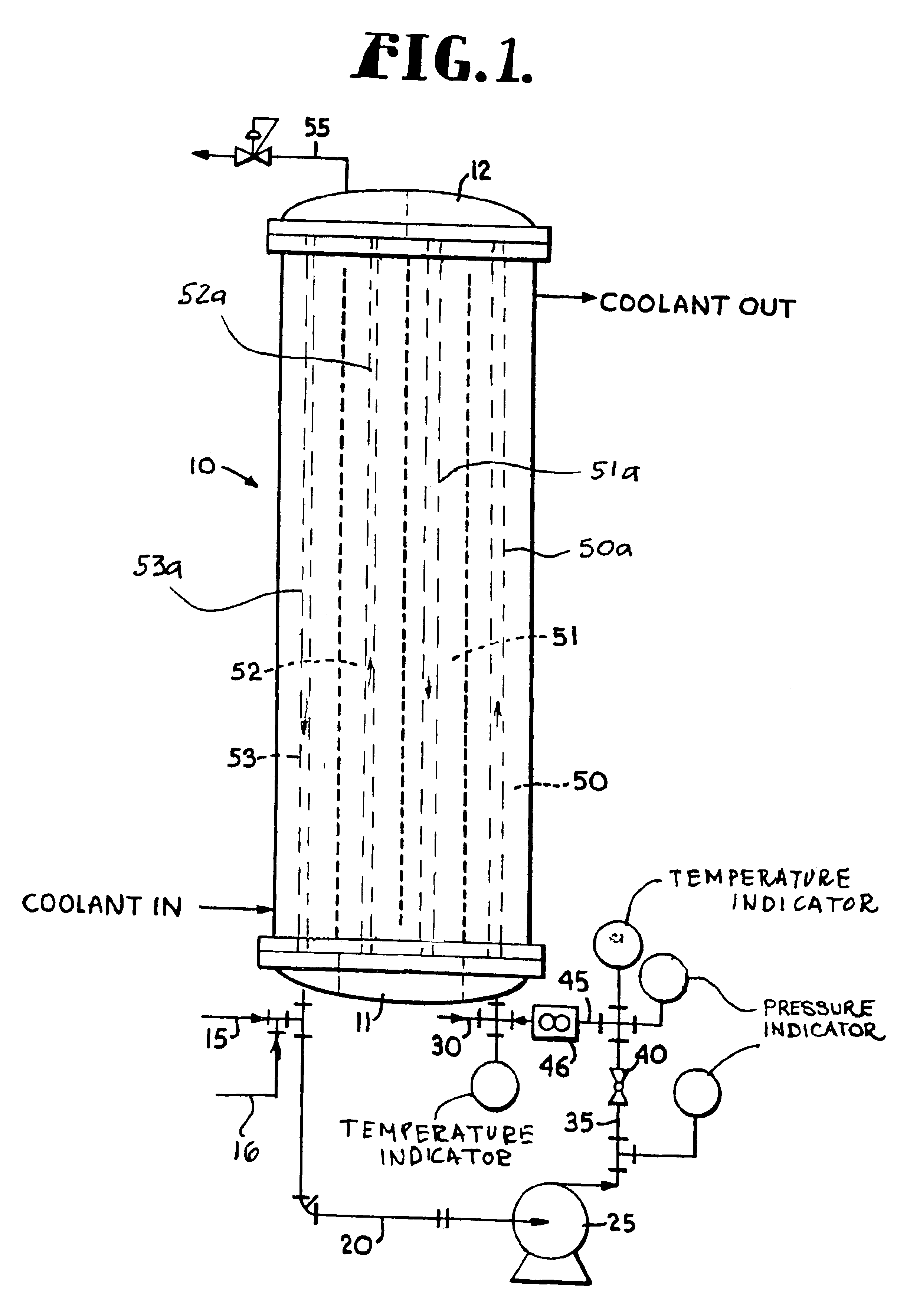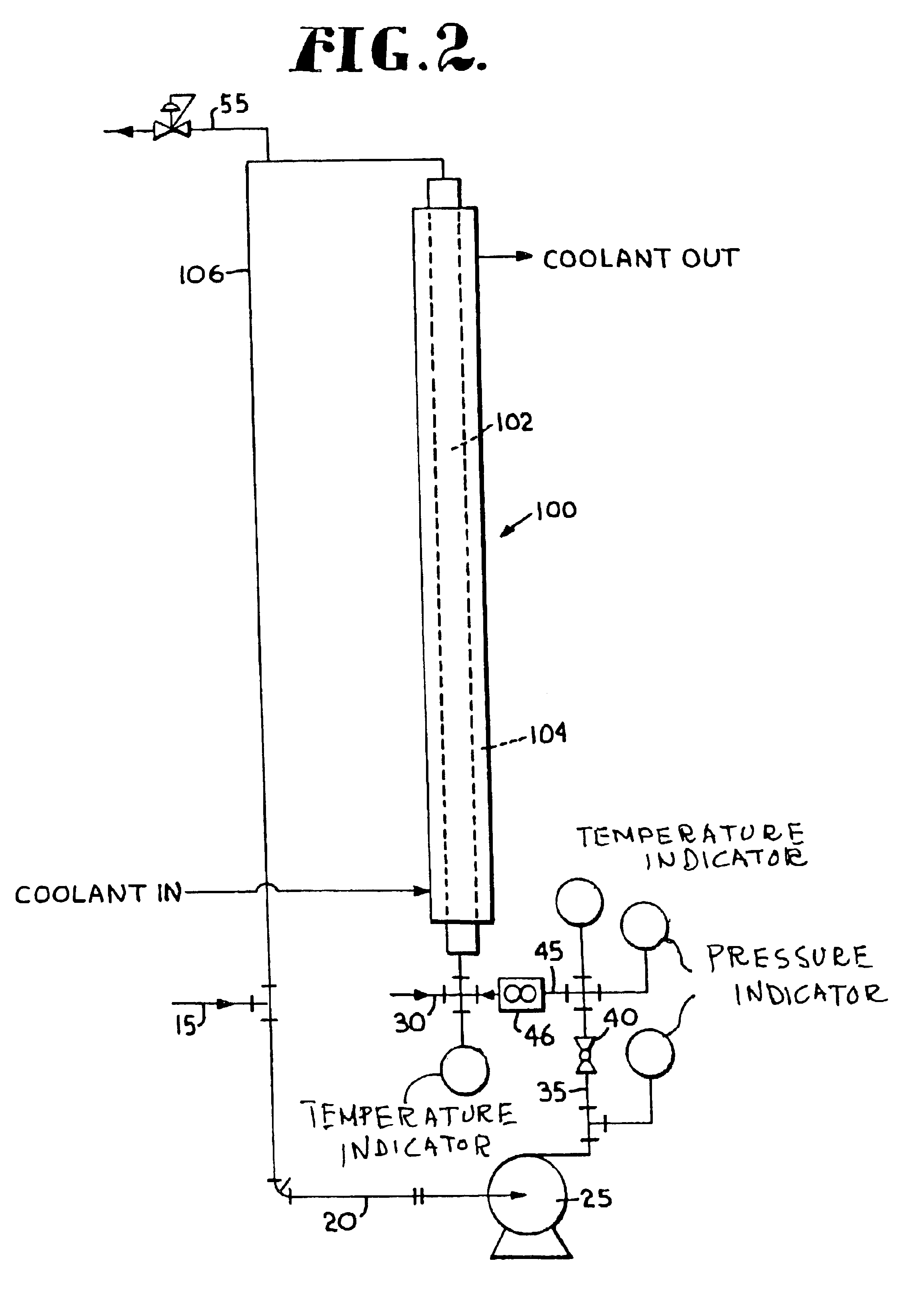Process for preparing polyolefin products
a technology of polyolefin and polyolefin products, which is applied in the field of olefin polymerization and to the preparation of polyolefin products, can solve the problems of troublesome use of alcohols having beta hydrogen atoms in such co-catalyst complexes, ineffective catalysts, and decomposition of alcohol, so as to achieve efficient and economical production and reduce reaction times
- Summary
- Abstract
- Description
- Claims
- Application Information
AI Technical Summary
Benefits of technology
Problems solved by technology
Method used
Image
Examples
example 1
[0075]Using the principles and concepts of the invention, a reactor such as the reactor illustrated in FIG. 1, was used to produce a low molecular weight, highly reactive polyisobutylene. The feedstock was essentially the same as shown above in Table 1, and the coolant circulated on the shell side of the reactor was a mixture of 35 weight % methanol and 65 weight % water. The inlet coolant temperature was 32° F. A 1:1 BF3 / methanol complex catalyst was used. All pertinent reactor data and dimensions are set forth below in Table 4.
[0076]
TABLE 4Feedstock flow rate1.7gpmRecirculation flow rate50gpmFeedstock density5lb / galConversion63wt %Concentration of isobutylene in92wt %feedstockΔHreaction398Btu / lbμ reaction mixture4.5 cP = 0.0030lb / ft secCp of reaction mixture0.46Btu / lb ° F.Reaction effective density44.9lb / ft3Thermal conductivity0.075Btu / hr ft ° F.Total volume of reactor recirculation390.2in3systemResidence time59.6secondsLinear velocity inside tubes9.3ft / secReynolds number3180Surfa...
example 2
[0083]A stream containing 2.19 wt % Isobutane, 61.5 wt % n-butane, 0.64 wt % 1-butene, 28.18 wt % trans-2-butene and 7.49 wt % cis-2-butene (35.66 wt % 2-butene) is introduced into the a loop reactor system of FIG. 2 via feed line 15 at a rate of 156 ml / min (93.6 g / min). A catalyst complex containing BF3 / methanol complex (one mole of BF3 to one mole of methanol) is fed to the reactor at a rate of 8 ml / min (10.4 g / min). The reaction temperature is maintained constant at 90° F. All pertinent reactor data and dimensions are set forth below in Table 6. The reactor effluent exits the top of the reaction loop via line 55 and is fed into a decant (not shown) were the catalyst is preferably separated out from the organic layer. A portion of the catalyst may then be recycled back to the reactor lowering the amount of fresh catalyst required. The product coming out of the decant overhead is mixed with NH4OH to quench any remaining catalyst in the organic phase and is sent to a second decant. ...
example 3
[0086]A stream containing 94.0 wt % 1-decene and 6.0 wt % C10-isomers was fed into the loop reactor of FIG. 2 at a rate of 10 ml / min (7.4 g / min). A catalyst complex containing BF3 / methanol complex (one mole of BF3 to one mole of methanol) was fed to the reactor at a rate of 1 ml / min (1.3 g / min). The reaction was held at a constant temperature of 70° F. All pertinent reactor data and dimensions are given in Table 8. Both the reactor setup and downstream catalyst removal steps are identical to Example 2. The product stream contained about 59.8 wt % of C20 oligomers and about 40.2 wt % of C30 oligomers.
[0087]
TABLE 8HC flow rate0.00264gpmPump around flow rate1.5gpmHC density6.2lb / gal% Conversion90wt %% 1-decene in feed stock94wt %ΔHrxn318Btu / lbμ1.2 cP = 0.0008lb / ft sCp0.50Btu / lb ° F.Reactor OD0.375inReactor wall thickness0.035inReactor ID0.305inReactor length10.5ftReactor volume9.2in3# of tubes1# of passes1Residence time905.13secondsLinear velocity6.59ft / sSurface area1.03ft2Heat generat...
PUM
| Property | Measurement | Unit |
|---|---|---|
| Fraction | aaaaa | aaaaa |
| Percent by mass | aaaaa | aaaaa |
| Substance count | aaaaa | aaaaa |
Abstract
Description
Claims
Application Information
 Login to View More
Login to View More - R&D
- Intellectual Property
- Life Sciences
- Materials
- Tech Scout
- Unparalleled Data Quality
- Higher Quality Content
- 60% Fewer Hallucinations
Browse by: Latest US Patents, China's latest patents, Technical Efficacy Thesaurus, Application Domain, Technology Topic, Popular Technical Reports.
© 2025 PatSnap. All rights reserved.Legal|Privacy policy|Modern Slavery Act Transparency Statement|Sitemap|About US| Contact US: help@patsnap.com


